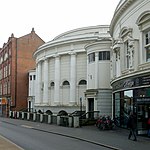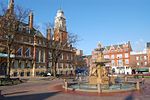Sue Townsend Theatre
EngvarB from October 2013Theatres in Leicester

Sue Townsend Theatre (formerly the Phoenix Theatre, Phoenix Arts Centre and the Upper Brown Street Theatre) is a theatre in the city of Leicester, England. The centre hosts live shows and films of the arthouse and world cinema genres. Julian Wright is credited for his work to preserve the theatre from demolition in the 1980s and in the 2000s. In 2010, after a new Phoenix Square opened on the other side of the city centre, the space became the Upper Brown Street Theatre, a music training and performance venue. It has since been renamed the Sue Townsend Theatre, to honour the late Leicester author and playwright, Sue Townsend.
Excerpt from the Wikipedia article Sue Townsend Theatre (License: CC BY-SA 3.0, Authors, Images).Sue Townsend Theatre
Upper Brown Street, Leicester Bede Island
Geographical coordinates (GPS) Address Nearby Places Show on map
Geographical coordinates (GPS)
| Latitude | Longitude |
|---|---|
| N 52.63125 ° | E -1.1351388888889 ° |
Address
Sue Townsend Centre
Upper Brown Street
LE1 5TU Leicester, Bede Island
England, United Kingdom
Open on Google Maps










